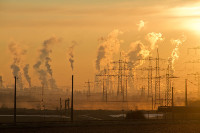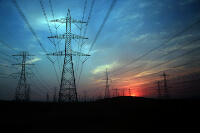
Welcome to Episode 4 of Warming World Explained. I’m Beth Stoeckly, your host. Today we will be talking about where computer models fit into climate science and about one of the reasons that making climate predictions is hard. But first, let me remind you that all the things I have talked about in previous episodes were not based on computer models.
In the mid-19th century, an Irish physicist named John Tyndall figured out that without the greenhouse gases in the atmosphere, which then were all naturally occurring, the surface of the earth would be colder than it actually was. At the turn of the 20th century, a Swedish chemist named Svante Arrhenius realized that the burning of fossil fuels would increase the concentration of carbon dioxide in the atmosphere and he calculated that doubling the carbon dioxide concentration would raise the average temperature 4 degrees Celsius. That estimate is within the range of current estimates.
In the last episode I talked about positive feedback loops, or vicious cycles, affecting climate. Those cycles exist and are observed. Understanding that does not depend on any computer calculations.
I am stressing this because when scientists talk about their recent results or the news reports on them, it may sound as if climate change is something discovered by computer modelling. That is not true. But people want to know more than the average temperature increase for the planet, because the earth does not warm or cool evenly. And we don’t experience global climate; we experience local weather.
Scientists would like to predict what changes will occur, where and when and how much. Besides predicting in detail what will happen if we continue the course we are on, they would like to predict the effect of any proposed remedy. Those problems are hard.
Some people expect scientists to always have precise answers. They recall a few years ago there was a solar eclipse that was visible from the United States. Long in advance, newspapers and websites showed maps of where the eclipse would be total and the exact time in each place. It turns out that predicting where the sun and earth and moon will be is straightforward, and we can measure precisely where they are, so we have good data to start the calculation. In fact, the ancient Mayans were able to predict eclipses without any understanding of what caused them, because they are cyclical. They observed carefully over many, many years and they found the pattern and used it to predict eclipses hundreds of years into the future.
We all know that weather isn’t like that. When I was young, people make jokes about weather predictions. Predictions have improved greatly in recent decades, but still hardly anyone publishes forecasts more than 10 days or 2 weeks ahead. I hope to talk about why this is so in a later episode, but the point here is that this makes some people doubt that computer modeling can do anything worthwhile at all in predicting climate.
Recently I had an opportunity to talk to an old acquaintance who has worked in the field of climate modeling. I asked what gives him confidence in computer calculations of climates. He said the best test is to use the model to calculate past events. That is, you start the model with climate data from some past time and see if it predicts what actually happened as time went on. Scientists do this for long ago climate changes like ice ages, and also for the recent past. He said that the results for the models people work with now are good enough that the models, in his words, “should be taken seriously”.
I didn’t ask exactly what he meant by that, but he did not mean that anyone can predict whether it will rain on your birthday 10 years from now. I believe he meant that the types of impacts that are predicted are possible, or even probable, even though we cannot make specific local predictions. He also said that on longer time scales like months or years and larger regions of space, the chaotic behavior which makes local weather hard to predict averages out. Remember the pot of water on the stove that I talked about in the first episode. We could predict the water would boil, even though we couldn’t predict exactly when it would start to boil. We knew that once it was boiling, water would turn to steam and escape into the air in the room, even though we could not predict exactly where in the pot the next steam bubble would start to form.
Predicting the day to day weather is more like predicting where the next bubble will form. Averaging over the whole pot and a period of time to predict that bubbles will form, water will turn to steam, and steam will escape into the air, is more like predicting climate. But climate is still a hard problem. The atmosphere is a large system with many different moving parts and changes in one place or one aspect can cause changes in others.
Perhaps before we talk about what makes modelling climate hard, we should talk a little about what computer models are. The computer is the ultimate idiot savant. It can do vast amounts or arithmetic with enormous speed, it can compare numbers, and it can store and retrieve information. Unfortunately, that is all it can do. All the complicated and amazing things we do with computers are possible because someone gave the computer a series of instructions, reducing the complicated and amazing things to a series of arithmetic, compare, store and retrieve operations. And if you have a problem that requires a lot of calculations, the computer makes possible what would otherwise be impossible. But the computer only does what is told to do.
When I was in college in the last 1960’s, people were just starting to use computers for many things and some people tended to think of them as having magical powers. There was a saying then, which is still true now: “Garbage in, garbage out” In other words, if your data or assumptions are bad, so will your answers be.
In order to consider the whole atmosphere of the earth, the scientists who do these things set up an array of points in the atmosphere. For example, one such model uses 19 altitudes, 192 latitudes, and 288 longitudes. Each combination of altitude, latitude and longitude defines one point. The points are separated by a few miles in height and about 90 miles horizontally. Even so, there are more than a million points.
For each point, you have to give the program data, such as the temperature, air pressure, humidity, wind velocity. Then the program uses known physical laws such as fluid mechanics and heat transfer to calculate the same set of quantities at the same points a short time later. The results of this become the new inputs for the next time step. And the computer does it all again, and then again.
Many arithmetic operations are required for each point at each time step, which is why there is a limit to how close together the points can be with available computers. The spacing used is close enough to show weather systems, but smaller things like clouds can’t be pictured directly. Formulas are used to approximate their effect.
This brings us to one major source of uncertainty in modeling: water vapor and clouds. Water vapor in the atmosphere acts as a greenhouse gas, tending to warm the earth. Clouds, on the other hand, are made of droplets of liquid water or of crystals of ice. The water absorbs and emits infrared radiation, but it also reflects incoming visible solar radiation, which tends to cool the planet. Whether the net effect in any region at any time is a net warming or a net cooling depends on the amount of water vapor in the air, the amount of cloud cover, the type of clouds, and a lot of details of cloud formation and the formation of drops large enough to fall to earth. The details are not completely understood, or predictable. In fact, exactly what goes on in clouds and how to model it in climate models is the largest area of controversy and uncertainty now adays among climate scientists.
Unlike carbon dioxide and methane, which last a very long time in the atmosphere and get spread all over the planet, water vapor reaches a new balance in weeks. For this reason, the concentration varies greatly from place to place and from time to time. But the amount of water vapor in the air has a limit which depends on temperature. The warmer the air, the more water vapor it can hold. When the concentration of water vapor reaches the maximum that the air can contain at a given temperature, we say the humidity is 100% or the air is saturated.
You see the effect of this if you live somewhere humid. During the warm part of the day, the air is just humid. As night falls and the air cools, there is just as much water vapor in the air as earlier, but the air can hold less. At some point the air becomes saturated and some of the water vapor condenses on the ground as dew. If the temperature is below freezing when the air becomes saturated with water vapor, it condenses as frost.
The dew falls on the grass, cars, houses, whatever surfaces there are, because it is very hard for water molecules to clump together by themselves in the air. It is easy if they have something to gather together on.
Higher up in the air, where clouds form, the droplets usually form on tiny particles called aerosols. These are particles small enough to stay in the air for a few days or a week. There are many kinds: dust from dust storms in the desert, volcanic ash, smoke and soot from fires (both natural and man made), sea salt from spray. An important class or aerosols contains sulfates. Most of the aerosols in the atmosphere occur naturally — maybe 90%. The rest are the result of human activity.
The aerosol particles themselves can absorb, reflect and scatter incoming sunlight. How much of each depends on the size and and color of the particles. Soot, for example, is black and absorbs most of the light that hits the particles. That tends to warm the layer where it is located, and the extra heat must be radiated away – in all directions – by infrared radiation. Other types of particles are bright and tend to reflect light.
Besides the direct effect, aerosol particles form the seeds for water droplets to form on in clouds. If there are many particles, then many small droplets will form. If there are fewer particles, then fewer, larger droplets will form from the same amount of water. But the cloud with a larger number of small droplets will reflect more incoming sunlight. This is like the case of ice: an ice cube will reflect light, but if you smash it into crushed ice, it will reflect more. The crushed ice – or the tiny droplets – have a lot more surfaces doing the reflecting. And it matters, because the net effect of water vapor in the air, water droplets and aerosol particles can be tending to warm the lower layers of the atmosphere or tending to shade, and therefore cool, the lower levels. But which happens and how strongly depends on things like the amount and kind of aerosol particles in each region. For some 40 years, people have understood that aerosols can have an effect on climate. But 40 years ago it was not possible to make accurate measurements of aerosols. Nowadays, using satellites, airplanes, and ground based observations, scientists can see the incoming sunlight and how much of it reaches the ground. Scientists have better data on the aerosols in the air, but it is still not as complete as they would like.
If all this sounds very complicated and confusing, then you have the gist. The effect of clouds – even whether the net effect is warming or cooling – is very difficult to predict and model. However, we know that it varies from region to region and from one time to another, because the presence and type of clouds vary.
It is also important to remember that the existence of the greenhouse effect does not depend on computer modeling. We turn to models for more detailed predictions. But we must keep in mind that the fact that their predictions don’t all agree in detail does not mean they are all wrong.
In the next episode, I plan to take a step back and talk about the science of energy and the different ways we use the word. Until then, goodnight for Warming World Explained.



